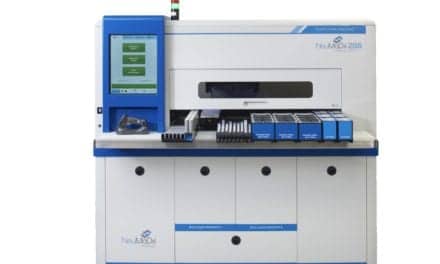Automated NGS platforms can help determine if a patient is fit for a targeted therapy, enabling more effective precision medicine, and improving patient outcomes.
By Andy Lundin
Next-generation sequencing (NGS) technology has helped establish a bond between the genomic testing and precision medicine spaces by providing medical professionals with an effective way to offer targeted therapies for patients.
In the clinical lab space, NGS technology has been a boon to in vitro diagnostics (IVD) processes through its parallel sequencing of DNA fragments, offering ultra-high throughput and scalability. Precision medicine is also harnessing NGS solutions for companion diagnostics (CDx) as a way to better help identify which therapies are best suited for individual patients.
CLP recently discussed with Luca Quagliata, vice president, global head of Medical Affairs at Thermo Fisher Scientific, the relationship between clinical lab testing and precision medicine, how community hospitals will benefit from investing in NGS solutions, why it’s crucial for pharmaceutical and diagnostic providers to work together, and more.
Quagliata’s responses have been edited for length and clarity.
CLP: What are some key innovations/developments regarding companion diagnostics (CDx)?
Luca Quagliata: With an increasing understanding of how genetic signals impact a patient’s response to treatment, more pharmaceutical companies are leveraging this knowledge to boost the development of new targeted therapies. As these drugs are approved and made available on the market, they often require a test—known as a companion diagnostic (CDx)—to identify patients who may benefit the most from a therapy based on their tumor’s unique genomic profile. It is often misperceived that genetic testing using CDx is complex and exclusively limited to large reference centers. We should increase awareness in the oncology community that this impression does not correspond to the reality of genomic testing today. Although we are just at the beginning, a paradigm shift will inevitably be driven by technological innovations and bring testing closer to patients.
Indeed, as never before, current genetic testing equipment is increasingly automated and fully integrated with solid software solutions for data interpretation. Lowering the process complexity threshold overall, thus positioning hospitals or labs to smoothly bring this technology in-house, and consequently, reducing the time to results, will enable molecular profiling by CDx to go mainstream and reach community hospitals.
It is crucial for pharmaceutical and diagnostic providers to work together to co-develop CDx tests and ensure they are readily available and accessible to patients as new therapies are approved, which will enable effective precision medicine and help improve patient outcomes, at a population level. For cancer patients, access to these tests and rapid delivery of results may end up saving lives.
CLP: How significant is the burgeoning relationship between CDx and NGS platforms for the future of precision medicine in community hospitals, and clinical lab testing in general?
Quagliata: The short answer is this is a crucial relationship for the future of precision medicine and clinical lab testing, especially for community hospitals. Nurtured by massive investments made in the field resulting in multiple CDx solutions available, pathologists today are enabled to increasingly conduct genomic profiling through NGS in lieu of single biomarker testing. This approach directly lowers the burden on patients and the overall healthcare system, given that usually one tissue biopsy sample can be used to detect multiple biomarkers at once, substantially reducing the risk of needing to return to the patient for an additional biopsy collection. This is usually a problem no matter where you are, but it is especially true within the community hospital setting. Democratizing precision medicine starts with democratizing access to testing. Thus, we need more CDx tests on multiple NGS platforms, as such ecosystem will enable full flexibility for testing based on clinical labs’ specific needs.
CLP: How do NGS platforms help address challenges for labs/hospitals in identifying precision medicines?
Quagliata: To determine if a patient is fit for a targeted therapy, clinicians first need a complete (i.e., knowing all clinically relevant biomarkers) and accurate (i.e., close to zero false positive or negative results) picture of that patient’s genomic profile. While there are many methods to do this, NGS platforms have recently gained a distinct advantage due to their lower throughput requirements and the increased use of automation in labs, making them ideally suited for community hospitals or lab settings closer to patients.
To realize the promise of these precision therapies and ensure genomic testing results are available when needed, Thermo Fisher has pioneered the fully automated end-to-end NGS workflow space through the launch of the Ion Torrent Genexus system.
This automated NGS solution is designed to minimize the need to train lab professionals on how to perform NGS tests, and also requires a lower sample throughput while delivering ultra-fast results in as little as 24 hours. As we continue to lower the threshold for NGS use, this will encourage and create room for more in-house NGS testing to inform the best care decisions for patients, ultimately matching patients with the right therapy right away.
CLP: What should labs in community hospitals take into consideration when looking to adopt NGS platforms?
Quagliata: When adopting NGS testing platforms, community hospitals should estimate how many samples they will need to evaluate within a certain timeframe along with the bandwidth of their staff. Carefully evaluating the different NGS solutions currently available, based on the above-mentioned items, will dictate the chances of succeeding in bringing that platform live in routine testing.
While some types of testing are automated, it is still necessary for community hospitals to measure the resources they have so hospital staff aren’t overloaded. Additionally, they should consider the cost of send-out NGS testing compared to the investment needed to bring NGS equipment in-house, and how this equipment could support multiple areas within their hospital—from research, to oncology, to infectious diseases, and reproductive health testing.
Further reading: Taking Next-Generation Sequencing from Proof of Concept to Diagnostic Reality
CLP: What are some challenges organizations may experience when adopting NGS-based companion diagnostic solutions?
Quagliata: At the very top, the most impactful challenges for adopting NGS-based CDx solutions are logistics—mostly related to lab space, sample workflow and management within the institution—and clinician and hospital manager behavior or awareness. Is your institution space constrained? Are your clinicians digitally savvy? These are some of the questions that need to be addressed before making the move to NGS. Capital expenditures investments might as well represent a barrier, hampered with uncertain reimbursement schemes, sometimes making the business case for NGS uptake being too complex to take on.
CLP: How does bringing companion diagnostics solutions closer to the patient impact care decisions?
Quagliata: By bringing companion diagnostic solutions in-house, testing results are more readily available, offering pathologists and oncologists the ability to inform care from the beginning of a patient’s medical journey. Instead of sending out a sample to a centralized lab and waiting anywhere from 15 days to weeks for results, in-house NGS testing can accelerate treatment initiation.
Rapid turnaround time can have a significant impact on patients as data presented last year at ASCO demonstrated the difference in non-small cell lung cancer (NSCLC) patient outcomes, including increased survival rates, when molecular testing results were available early enough to inform treatment decisions right away.
Researchers looked at real-world data from 525 newly diagnosed NSCLC patients in community hospitals across the United States. This study showed that molecular testing through rapid NGS is a critical first step in determining the best course of treatment for cancer patients and improves survival rates.
CLP: Is there any data/case studies available that supports the importance of NGS-based companion diagnostic solutions for community hospitals?
Quagliata: Case studies supporting in-house testing are multiplying day by day. In one recent example, Brandon Sheffield, an MD, serving at William Osler Health System in Ontario, a community hospital supporting the area surrounding Brampton, west of main Toronto, was able to accelerate the hospital’s testing turnaround time from over 20 days using outsourcing providers to as low as 2 to 5 days by sequencing samples onsite. With this approach, Osler clinicians have test results available 94% of the time during a patient’s first consult, compared to 17% of the time when they were outsourcing testing.
The earlier availability of test results not only improves patient care, but also has an economic benefit as the cost of the additional physician visit is more expensive than an NGS assay. When testing is available closer to patients, those in need of treatment will be able to be matched with the most clinically relevant targeted therapies more quickly, delivering on the promise of precision medicine.
Another study explored how community hospitals can effectively test for NTRK gene fusions without outsourcing samples, which can be costly and time consuming to deliver results. Currently, as only one companion diagnostic assay for NTRK fusion detection is approved by the FDA, clinical laboratories use a range of laboratory-developed NGS assays to detect NTRK fusions. Again, Dr. Sheffield’s research, published in The Journal of Molecular Diagnostics, evaluates four on-market assays and their ability to reliably detect NTRK fusions to help pathologists and physicians make informed choices on testing methods. This research demonstrates that tools currently available can help community hospitals bring NGS in-house and match patients to new, cutting-edge therapies.
As more targeted therapies for cancer come to market and pharmaceutical companies look to extend the reach of the treatments already approved, accessible CDx testing that delivers rapid results is imperative to match eligible patients to these therapies before they are started on a different, potentially ineffective treatment.
Andy Lundin is associate editor of CLP





